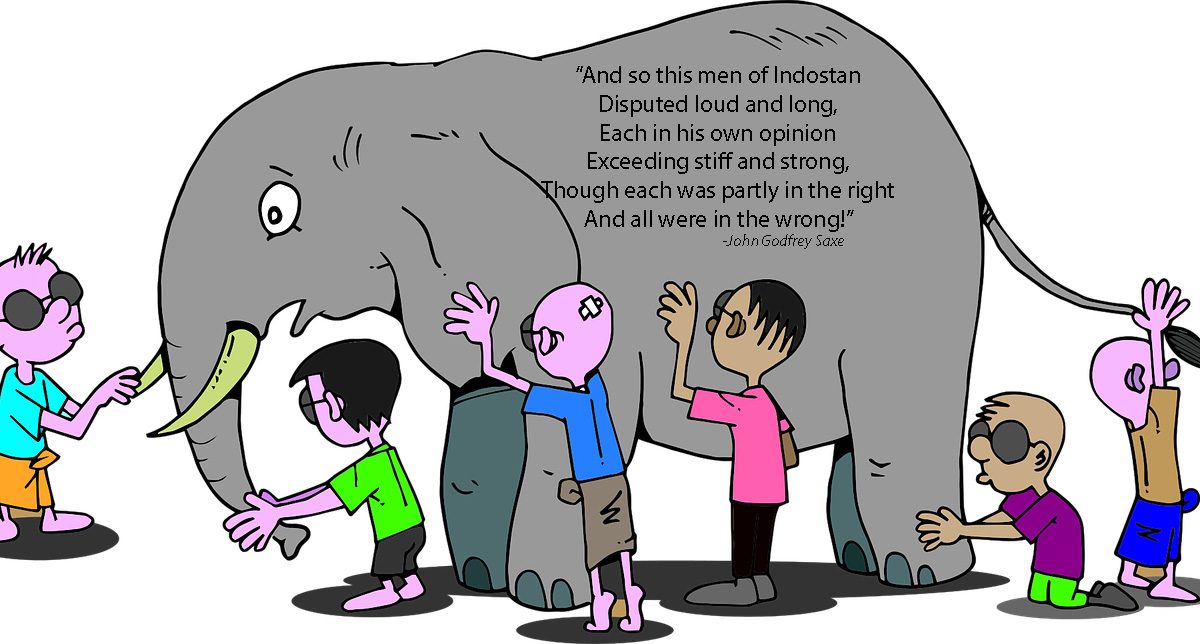
What to do for Lent?
February 3, 2023
Sister Marie Andree Chorzempa, OSF
February 10, 2023By Sister Judith Ann Zielinski, OSF
Several hundred years ago (it seems) when I taught 5th and 6th grade English at Regina Coeli School in Toledo, I discovered a quaint poem that delighted me: The Blind Men and the Elephant, written by Vermont educator and journalist John Godfrey Saxe in 1877. However, earlier versions of the fable are found in Buddhist, Hindu, Sufi and Jain texts.
The fable tells this story: A group of blind men hear that a strange animal, called an “elephant,” has been brought to the town. Out of curiosity, they say, “We must inspect and know it by touch, of which we are capable.” So, they circle the elephant and grope about it.
The first blind man, whose hand lands on the trunk, says, “This being is a thick snake.” The second man, whose hand touches its ear, says that it seems to be a kind of fan. The third touches its leg and proclaims that the elephant is a pillar, like a tree-trunk. The one who touches its side says the elephant is a wall. The next, who grips the tail, describes it as a rope. The last one seizes its tusk and proclaims the beast is hard and smooth, like a spear.
Six completely different perceptions of the one beast!
In some versions, the blind men argue about their conclusions, suspect the others of lying, and come to blows. In other versions, they stop arguing, start listening and collaborate to “see” the full elephant. The blind men learn that they were all partially correct and partially wrong.
Franciscan Richard Rohr has written extensively on the need to move from dualistic thinking (the blind men!) to contemplative seeing.
Dualistic thinking leads us to make an immediate decision and firmly reject all other possibilities. Dualistic thinking is important and necessary for many tasks—making a left turn, measuring and cutting fabric for a curtain, writing a check to pay the rent. For more complex human realities, though, dualistic thinking doesn’t work. We need contemplative seeing.
In that mode, we are invited to look at the entire picture—not just the detail we may be drawn to or the “lizard-brain reaction” that flashes immediately to the fore. We are challenged to hold the entire controversial and often difficult question—social realities such as immigration, abortion, capital punishment, women’s ordination, gender identity, Black Lives Matter, etc– without judgment, pondering the complexities and holding the tension without trying to resolve it. Instead, we enlarge the space to ask:
What are other people seeing and experiencing that I am not?
What is their truth?
What part of THIS elephant is hidden from me?
Rohr urges us to become “contemplatives in action”—people without need of cloisters or confinement, but engaged deeply and lovingly in our world—people who see the whole, accept reality without judgment or exclusion, and ponder a compassionate and generous response.
This is not child’s play. It is second-half-of-life wisdom which requires courage, openness and humility. In our embattled culture and church, this approach could help people listen to each other, take baby-steps toward dialogue, invite “enemies” to emerge from behind barricades, to request that everyone be heard, and reflect on each other’s very different perspectives.
Otherwise, like the blind men, we
…tread on in utter ignorance, of what each other mean,
and prate about the elephant, not one of us has seen!








Thanks, Judy! Richard Rohr has been a wonderful mind/soul-opening spiritual influence in my life. You have also been an influence with your insightful blogs, videos and storytelling.
Mary T.
As always, a humorous, yet poignant take on many of today’s realities. Definitely elephants in the room. Thank you for challenging me to take another look from within.
Thanks so much for another fine blog reflection, dear Sister Judy. Blessings on you and all that you are and do to inspire others. Sent with gentle hugs, Brigid